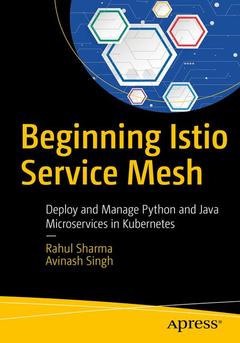Description
Getting Started with Istio Service Mesh, 1st ed.
Manage Microservices in Kubernetes
Authors: Sharma Rahul, Singh Avinash
Language: English
Subject for Getting Started with Istio Service Mesh:
Keywords
istio; microservice; kubernetes; gateway; traffic; monitoring; deployment; grafana; prometheus; resiliency; telemetry; security; Java; Python
Approximative price 47.46 €
In Print (Delivery period: 15 days).
Add to cart321 p. · 15.5x23.5 cm · Paperback
Description
/li>Contents
/li>Biography
/li>Comment
/li>
Build an in-depth understanding of the Istio service mesh and see why a service mesh is required for a distributed application. This book covers the Istio architecture and its features using a hands-on approach with language-neutral examples. To get your Istio environment up and running, you will go through its setup and learn the concepts of control plane and data plane. You will become skilled with the new concepts and apply them with best practices to continuously deliver applications.
What You Will Learn
- Discover the Istio architecture components and the Envoy proxy
- Master traffic management for service routing and application deployment
- Build application resiliency using timeout, circuit breakers, and connection pools
- Monitor using Prometheus and Grafana
- Configure application security
Developers and project managers who are trying to run their application using Kubernetes. The book is not specific for any programming language even though all examples will be in Java or Python.
Rahul Sharma is a seasoned Java developer with over 14 years of industry experience. In his career, he has worked with companies of various sizes, from enterprises to start-ups. During this time he has developed and managed microservices on the cloud (AWS/GCE/DigitalOcean) using open source software. He is an open-source enthusiast and shares his experience at local meetups. He is the co-author of Java Unit Testing with JUnit 5 (Apress, 2017).
Avinash Singh is an IIT-Kanpur alumnus with more than ten years of experience in architecture, design, and developing scalable and distributed cloud applications. He has hands-on experience in technologies such as AWS Cloud, J2EE, ROR, MySQL, MongoDB, Spring, and Hibernate. Avinash has a strong understanding of SOA and microservices architecture, with good handle on resource capacity planning.
Covers best practices for distributed application release and deployment
Includes a hands-on approach by working with language-neutral examples
Decodes the concept of Blue-Green deployment for your service




